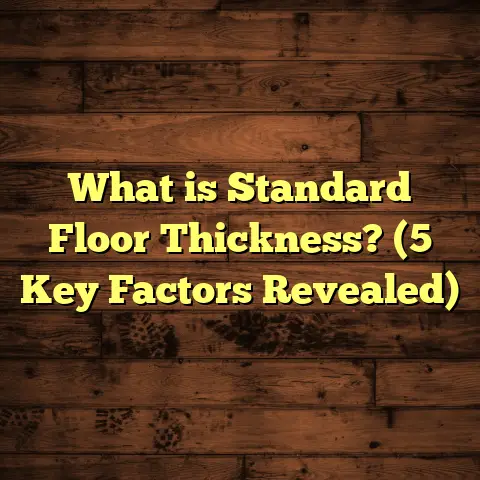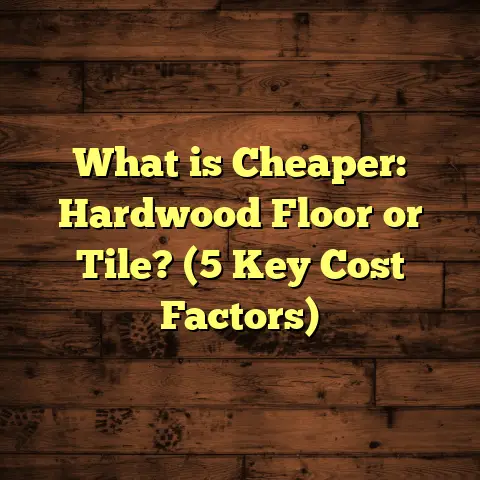What is Mil for Flooring? (5 Key Benefits Explained)
I remember the first time I heard the term “mil” while discussing flooring options with a client. She was puzzled, asking me, “What exactly is mil for flooring?” I realized then that many people don’t quite grasp what mil means or why it matters when choosing or installing floors. It’s one of those little details that can make a big difference in the durability and performance of your floors.
So, what is mil for flooring? Simply put, a mil is a unit of measurement used to describe the thickness of a material, especially flooring wear layers like vinyl or laminate. One mil equals one-thousandth of an inch (0.001 inch). When you hear someone say a vinyl floor has a wear layer of 20 mils, it means that layer is 0.020 inches thick. The thickness impacts how well the floor holds up to daily use, scratches, stains, and moisture.
Let me walk you through the concept in more detail and share some insights from my years working with different flooring materials. I’ll also talk about how mil thickness affects installation, maintenance, and overall cost-effectiveness.
What Does Mil Mean in Flooring?
When people talk about mil in flooring, they’re mostly referring to the thickness
of the wear layer—the protective top coat on vinyl or laminate floors.
This wear layer shields the decorative layer underneath and affects the floor’s
durability.
For example:
- A 12-mil wear layer is usually found in residential vinyl flooring.
- A 20-mil or higher wear layer is typical for commercial-grade vinyl floors.
- Some premium options offer up to 30 mils or more for extra toughness.
The mil measurement tells you how resistant the floor will be to scuffs, dents, and general wear. The thicker the wear layer, the longer your floor will look good.
I’ve worked on many projects where clients initially chose thinner wear layers to save money but ended up regretting it because their floors wore out faster than expected. It’s a classic case of “penny wise, pound foolish.”
Why Does Mil Thickness Matter?
Think about a vinyl plank floor in a busy kitchen or retail store. It needs
to withstand heavy foot traffic, spills, and furniture movement without
getting scratched or gouged. A thicker wear layer (higher mil) provides
extra protection.
Here are five key benefits of understanding and choosing the right mil for your flooring:
1. Enhanced Durability
The thicker the wear layer, the better your floor can resist scratches, dents,
and stains. This is especially important in busy homes with kids, pets, or
high-traffic commercial spaces.
In one project I handled for a daycare center, they installed vinyl flooring with a 28-mil wear layer. After two years of constant activity and cleaning, their floors showed barely any signs of wear. Contrast that with a similar daycare using 12-mil vinyl that needed replacement within 18 months.
2. Improved Longevity
A higher mil rating doesn’t just protect against surface damage; it extends
the overall life of your flooring. That means you won’t need to replace or
repair it as often.
According to industry data from the Resilient Floor Covering Institute, vinyl floors with at least 20 mils of wear layer can last 10-15 years under moderate use — about twice as long as floors with 12-mil layers.
3. Better Resistance to Moisture and Stains
Thicker wear layers offer better barriers against moisture penetration and
staining substances like wine or coffee. This is key in kitchens, bathrooms,
and basements where spills happen frequently.
I remember advising a client who had a basement prone to dampness to choose vinyl flooring with at least a 20-mil wear layer combined with waterproof core technology. This choice saved them from costly water damage repairs later on.
4. Easier Maintenance and Cleaning
With a thicker wear layer, scratches and scuffs are less likely to show up,
making cleaning simpler and less frequent.
In my experience working with commercial cleaners, floors with higher mil ratings tend to require less aggressive cleaning methods, which preserves the floor’s finish and makes upkeep easier.
5. Increased Comfort and Sound Insulation
While this benefit isn’t always highlighted, thicker wear layers contribute to
the overall feel underfoot and can slightly reduce noise from footsteps.
For example, luxury vinyl tile (LVT) products with a 20-30 mil wear layer often come with padding or backing that improves comfort and sound absorption—great for apartments and offices.
How to Choose the Right Mil for Your Project?
Choosing the right mil depends on your specific needs—budget, traffic level, room type—and what kind of protection you want from your flooring.
- Residential light use: 12-20 mil wear layers are usually sufficient.
- Residential heavy use: Consider 20-28 mil for kitchens or entryways.
- Commercial use: Look for 28+ mil for high traffic and durability.
- Special areas: Bathrooms and basements benefit from thicker, waterproof options.
I always recommend clients think about long-term value rather than just upfront cost. Yes, thicker wear layers cost more initially but save money by lasting longer and needing fewer repairs.
Installation Tips for Flooring with Different Mil Thickness
Here’s something I’ve learned over time: installation methods don’t change drastically based on the mil thickness, but there are some nuances worth knowing:
Handling Thicker Wear Layers
Thicker wear layers add a bit more rigidity to planks or tiles. This means:
- You need a flatter subfloor to avoid telegraphing imperfections.
- Cutting requires sharp tools since the material is denser.
- Weight increases slightly—plan for that if you’re installing multiple rooms at once.
Underlayment Considerations
Some thicker wear layers come pre-attached with underlayment for support and sound reduction. If not, choose an underlayment compatible with your floor type. For example:
- Vinyl floors with >20 mil wear layers often pair well with foam or cork underlayment.
- Laminate floors may require special vapor barriers alongside underlayment.
Acclimation
Allow your planks or tiles to acclimate in the installation area for at least 48 hours regardless of thickness. This prevents expansion or contraction issues later on.
Maintaining Floors by Mil Thickness
Maintenance varies by material but knowing your wear layer thickness helps you adjust your care routine:
- Thinner layers (12-15 mil): Avoid harsh scrubbing or abrasive cleaners.
- Medium layers (15-20 mil): Regular mopping with gentle cleaner works well.
- Thicker layers (20+ mil): These floors tolerate deeper cleaning and occasional buffs.
In my experience cleaning floors after commercial jobs, I found that floors with at least 20 mils can handle steam mopping occasionally without damage—something thinner layers cannot tolerate.
Case Study: Comparing 12 Mil vs. 24 Mil Vinyl Flooring in a Family Home
I recently worked on two homes side by side: one installed 12-mil vinyl in the living room; the other went with 24-mil in the same area. Both families had similar lifestyles—kids, pets, lots of foot traffic.
After three years:
- The 12-mil floor showed visible scratches near entryways and furniture legs.
- The 24-mil floor looked almost new except for minor dirt marks easily cleaned off.
- The homeowners of the thicker floor reported no need for repairs or replacement plans yet.
- The thinner wear layer home was already discussing refinishing or replacement options.
This real-world example clearly shows how investing in higher mil thickness pays off for durability and peace of mind.
Unique Insights from My Flooring Experience
Over nearly two decades installing floors across regions with varying climates, I’ve noticed that:
- Humidity levels impact wear layer performance: Thicker layers hold up better in humid areas because they resist moisture ingress.
- Wear layer color transparency: Some thicker layers have clearer coatings that preserve the design underneath longer without yellowing.
- Environmental impact: Floors with longer lifespans reduce waste—so choosing higher mil thickness supports sustainability goals too.
Mil Thickness Compared Across Flooring Types
People often assume “mil” only refers to vinyl flooring but it applies differently depending on flooring type:
| Flooring Type | Typical Wear Layer Thickness (mils) | Notes |
|---|---|---|
| Vinyl (Luxury Vinyl Tile/Plank) | 12 – 30+ | Thickness directly linked to durability |
| Laminate | Thin wear layer but measured differently (usually microns) | Protective top coat varies; similar principles apply |
| Engineered Hardwood | Not measured in mil; thickness measured in mm | Wear layer is real wood; thickness varies from 1mm to several mm |
| Carpet | Not applicable | Durability measured differently |
Understanding that “mil” mostly applies to resilient flooring helps you focus on where it matters most.
How Mil Thickness Affects Cost
One of the first questions I get from clients is: “Does thicker mean way more expensive?”
The answer: yes — but not dramatically so when you factor in longevity.
Here’s what I’ve seen:
- A basic 12-mil vinyl floor may cost $2-$3 per square foot.
- A premium 20-28 mil option can run $4-$6 per square foot.
- Commercial-grade (30+ mil) can go upwards of $7-$9 per square foot.
Remember, these prices include materials only; installation adds roughly $1-$3 per square foot based on complexity.
If you compare total cost over time — factoring in replacement cycles every 3-5 years for thinner versus 10+ years for thicker — the initial price gap narrows considerably.
Mil Thickness and Warranty Considerations
Warranties often correlate directly with mil thickness:
- Floors with lower mil ratings tend to have shorter warranties (5-7 years).
- Higher mil floors usually come with warranties ranging from 10 up to 25 years depending on brand.
Always check warranty details carefully because some manufacturers void coverage if improper installation or maintenance occurs—even if thickness is adequate.
My Personal Story About Choosing Mil Thickness
Years ago, I helped renovate my own kitchen using vinyl plank flooring. I was tempted by a cheaper 12-mil product because my budget was tight. After chatting with a flooring rep about how much cooking spills and kids’ activities would stress the floor, I decided to upgrade to a 24-mil option instead.
That choice paid off big time. Over six years later:
- The floor looks nearly flawless.
- Cleanup is quick; stains don’t penetrate.
- No signs of edge lifting or peeling despite heavy use.
It reminded me that sometimes spending more upfront saves headaches down the road.
Common Myths About Mil Thickness
I’ve encountered some misconceptions over time:
Myth #1: Thicker always means better quality
Not necessarily. While thicker wear layers tend
to be tougher, quality depends on manufacturing processes too. Some brands produce thin but highly durable coatings using advanced polymers.
Myth #2: Mil only matters for commercial spaces
Even homes benefit from higher mil rating floors in busy areas like kitchens and hallways. Your living room might not need it but think about where shoes track dirt and moisture daily.
Myth #3: You can’t install thicker floors yourself
Installation difficulty doesn’t increase much with thickness; most DIYers handle these projects fine with proper prep and tools. The key is subfloor preparation and acclimation—not mil number.
How Mil Thickness Influences Design Choices
You might wonder if thicker wear layers limit design options? Not really.
Manufacturers offer a wide variety of colors and textures regardless of thickness level because:
- Decorative layers are printed underneath protective coats.
- Thicker layers just add durability without compromising appearance.
- Some high-end options combine thick wear layers with realistic wood grain embossing or stone textures for authentic looks.
If you want style plus substance, look for LVT flooring around 20-30 mils thick—they balance beauty and function well.
Preparing Your Subfloor According to Mil
Getting installation right starts below the surface.
Here’s what I always check before laying down planks or tiles:
- Levelness: Floors must be flat within ±3/16 inch over 10 feet. Thicker wear layers are less forgiving of unevenness because they can show bumps through.
- Cleanliness: Remove dust, dirt debris—especially important for glue-down installations.
- Moisture Levels: Use moisture meters especially in basements or concrete slabs. High moisture can cause damage even with thick wear layers if not addressed.
- Old Flooring Removal: Sometimes leaving old vinyl under thin new layers causes uneven surfaces; better remove it first if possible.
Tools You Need When Working With Different Mils
Whether professional or DIYer, these tools come in handy:
| Task | Recommended Tool(s) |
|---|---|
| Cutting thicker planks | Utility knife with fresh blades; vinyl cutter |
| Measuring & leveling | Laser level; tape measure |
| Subfloor prep | Floor scraper; vacuum; patching compound |
| Installation | Rubber mallet; spacers; tapping block |
| Cleaning | Microfiber mop; neutral pH cleaner |
Keep blades sharp especially when cutting thicker materials—they resist dulling faster than thin ones.
Environmental Impact & Sustainability of Different Mil Thicknesses
I’m often asked if thicker floors mean more waste or environmental harm.
Actually:
- Longer-lasting floors mean fewer replacements → less landfill waste.
- Some manufacturers use recycled content within wear layers regardless of thickness.
- Thicker wear layers sometimes allow for refinishing instead of full replacement (in engineered wood/laminate context).
If reducing environmental footprint matters to you, weigh durability alongside materials used—not just thickness alone.
Troubleshooting Common Issues Related to Mil Thickness
Some challenges may arise depending on thickness chosen:
Surface Scratches Despite High Mil
If you notice scratches on high-mil floors early on:
- Check if abrasive particles are tracked inside regularly.
- Consider adding rugs/mats in high-impact zones.
- Make sure cleaning products are manufacturer-approved (avoid wax/polish).
Edges Peeling Up or Curling
Sometimes edges lift after installation due to improper acclimation or subfloor moisture—not necessarily related directly to thickness but more common on heavier planks if subfloor moves beneath them.
Discoloration & Yellowing
Thinner wear layers sometimes yellow faster under UV exposure or harsh chemicals—thicker ones usually resist this better but still protect from direct sunlight when possible by using window treatments.
Involving Professionals vs DIY When Considering Mil Thickness
If you’re unsure about handling installation yourself:
- Pros have experience managing nuances like subfloor prep critical for thicker materials.
- They can recommend appropriate underlayments based on your chosen mil thickness.
- Professional work may qualify for warranties invalidated by DIY mistakes.
However,
DIYers who prepare well find most LVT installations manageable regardless of thickness by following instructions closely.
How Online Tools Like FloorTally Help With Mil Decisions
To estimate costs realistically based on different mil options, I often use FloorTally myself when advising clients:
- Enter room dimensions.
- Select material types & desired wear layer thickness.
- See breakdowns including labor rates & waste factors.
- Compare alternatives visually side by side before deciding.
This tool saves time and gives peace of mind budgeting accurately without guesswork.
Conclusion: Why Paying Attention to Mil Changes Everything
Choosing your floor’s mill thickness might seem technical at first glance—but it’s one
of those small details that make a big difference in daily life and future expenses.
From enhanced durability and stain resistance to easier maintenance and longer warranties—knowing what “mil” means helps you pick smarter floors that stand up better over time without breaking your budget repeatedly down the road.
I hope sharing my experiences plus detailed info helps you feel confident when making this choice yourself!
If you want tailored advice based on your specific space or lifestyle needs—or help estimating costs using real-world data—just ask away! Flooring isn’t just my job—it’s my passion to help people get it right the first time.





